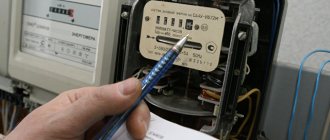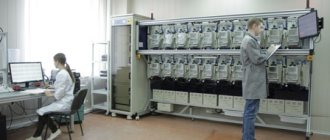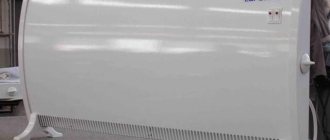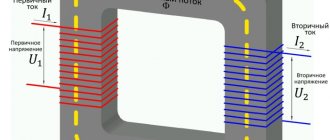Requirements for installation sites
1. In accordance with the law, when installing metering devices in cases not related to technological connection, metering devices must be installed in the places specified in the documents on technological connection and (or) acts of admission to operation of electrical energy metering devices, and it is necessary to follow a document (act) that was drawn up and signed later.
In the absence of information about the installation locations of metering devices in the documents on technological connection and (or) certificates of approval for operation of electrical energy metering devices or in the absence of the technical possibility of installing the metering device in the specified locations, unless otherwise established by agreement of the parties, the metering device must be installed on the border of the balance sheet accessories of electric power facilities (power receiving devices) of related entities.
If there is no technical possibility of installing a metering device at the border of the balance sheet, unless otherwise established by agreement of the parties, the metering device must be installed in a place as close as possible to it, in which there is a technical possibility of its installation.
It is not technically possible to install a metering device if at least one of the following conditions is met:
- installation of a metering device according to the design characteristics of the installation sites is impossible without reconstruction, major repairs of existing energy receiving devices, electrical energy (power) production facilities or electrical grid facilities and (or) without the creation of new capital construction facilities;
- When installing a metering device, it is impossible to ensure compliance with the mandatory metrological and technical requirements for the metering device, including the conditions for its installation and operation, imposed in accordance with the legislation of the Russian Federation on ensuring the uniformity of measurements and on technical regulation.
The conditions of the absence of the technical possibility of installing a metering device do not apply to the technological connection of power receiving devices of electrical energy consumers, electrical energy production facilities, as well as electrical grid facilities belonging to network organizations and other persons to electrical networks.
When technologically connecting power receiving devices of electrical energy consumers, electrical energy production facilities, as well as power grid facilities belonging to network organizations and other persons, to electrical networks, the meter must be installed at the border of the balance sheet ownership of power facilities (power receiving devices) of adjacent entities. In this case, the metering device can be installed within the boundaries of electric power facilities (power receiving devices) of an adjacent entity by agreement of the parties or in other cases provided for by the Technological Connection Rules.
If, in relation to a dilapidated and (or) emergency facility, a metering device was not previously allowed into operation, the implementation of the responsibilities of the network organization (guaranteed supplier - in relation to collective (common house) metering devices), provided for in paragraph 136 of this document, in relation to the points of delivery of such objects is carried out no earlier than their owner (management organization, homeowners' association, housing cooperative or other specialized consumer cooperative (hereinafter referred to as the person managing the apartment building), and in the case of direct management of the owners of premises in an apartment building - a person attracted by the owners of premises in an apartment building house under contracts for the provision of services for the maintenance and (or) performance of repairs of in-house electrical systems) reconstruction, as a result of which the circumstances that cause the technical impossibility of installing a metering device and receiving an application from such an owner to install a metering device will be eliminated. A network organization has the right to install a metering device at electrical grid facilities (with the exception of collective (common house) metering devices) belonging to such network organization by right of ownership or other legal basis, with notification to the owner of the dilapidated and (or) emergency facility that there is no need to eliminate the circumstances that constitute the reason for the technical impossibility of installing a meter within the boundaries of such objects.
2. The metering device must be placed in a locked metering cabinet at a height of 0.8-1.7 m in a vandal-proof design, with a degree of protection of the housing from dust and moisture no worse than IP54, which must have a window at the level of the dial for taking readings from counter and the possibility of sealing the cabinet door.
When organizing metering at the border of the balance sheet, the metering cabinet must be installed in close proximity to the connection point on the 0.22(0.4) kV overhead line support to which the consumer facility is connected or the actual connection of the consumer facility to the electrical network is intended.
It is allowed to use a metering device in a split version with a degree of housing protection from dust and moisture no worse than IP54, with mounting on a support or on the input wire line at a height of more than 1.7 m. In this case, the metering device must be equipped with a remote (remote) display.
The procedure for installing an electric meter in an apartment
Before installing an electricity meter in your apartment, you must obtain permission from your local service provider. In this case, you must act as follows:
- The consumer writes an application to the energy sales company at his place of residence stating that he wants to install an electric meter in his apartment. After this, within a few days (maximum a week), his data is entered into the state register.
- The service provider then issues a resolution authorizing the procedure for replacing or installing the electric meter, on the basis of which the consumer is issued a certificate for the purchase of a new device. You cannot purchase an electric meter in a store or energy sales company without such a document.
Each device is accompanied by a passport, which describes the main parameters and characteristics of the device. They must coincide with those indicated in the certificate of the energy sales organization. The device passport must be kept permanently, since data on inspections by controllers of the service company are subsequently entered into it.
Recommended articles on this topic:
- Electrical installation in the apartment
- Stages of renovation in an apartment
- Turnkey cosmetic repairs
Installing an electric meter in an apartment with your own hands is only possible if you are a qualified specialist and have the appropriate permit with the third form of electrical safety. Otherwise, you need to invite an outside specialist. Installation of an electric meter in an apartment is carried out in the following order:
- The device is de-energized by turning off the input circuit breaker.
- The meter is unsealed and the casing is removed.
- The wires are disconnected from the device taking into account the color scheme.
- After the electric meter is completely de-energized, it is removed from the wall.
- Unscrew the bolts in the device body using a Phillips screwdriver.
Installation of a new device is carried out in the reverse order. The installation height of the electric meter in the apartment should be such that it is convenient for the consumer to use it - approximately at eye level. Upon completion of installation, the equipment must be tested to ensure its functionality. To do this, turn on several electrical household appliances. If the electric meter is working normally, then it is sealed.
Requirements for electricity metering devices
- Installed electrical energy metering devices must comply with the requirements of the Rosseti PJSC Standard General technical requirements for metering devices (STO 34.01-5.1-009-2019)
- To account for consumed (produced) electrical energy, multi-tariff three-phase/single-phase devices must be used, the type of which is approved by the federal executive body for technical regulation and metrology, entered into the Federal Information Fund for Ensuring the Uniformity of Metering Measurements, an accuracy class that meets the requirements of the rules for providing access to the minimum set of functions of intelligent electrical energy (power) metering systems (approved by Decree of the Government of the Russian Federation of June 19, 2022 N 890), and for consumers - with a maximum power of at least 670 kW, including metering devices that provide storage of data on hourly volumes consumption of electrical energy over the last 90 days or more, i.e. with an accuracy class of at least 1.0 (0.5S and higher for three-phase transformer connection metering devices); operating temperature range from -40 to +60. The metering device must provide load control, parameterization and data transmission via one or more digital communication channels using a built-in or plug-in modem; a single-phase meter must have an optical interface, a three-phase meter must have an optical interface and an RS-485 interface; provide cumulative measurement of electricity and calculation of average power over hourly time intervals; the calibration interval of electricity meters must be at least 10 years for three-phase and 16 years for single-phase metering devices.
It is mandatory to have state verification seals on the screws securing the meter casing, no more than 12 months old for three-phase meters and no more than 2 years old for single-phase meters, at the time the electrical installation is switched on (in accordance with clause 1.5.13 of the PUE) ;
The accuracy class of instrument transformers used in measuring systems for installing (connecting) metering devices must be at least 0.5.
Rules for installing an electric meter in an apartment
When buying an electric meter, pay attention to the date of its release and the date of verification. You can find out when the meter was verified by examining the inscription on the housing seal. Arabic numerals indicate the year of verification, and Roman numerals indicate the quarter. You cannot use equipment with expired verification dates (they are regulated by the PUE).
Although the design of the switchboard is not defined by the rules, the standards for installing an electric meter in an apartment contain some requirements for its placement:
- Accessibility of terminals and transformer of the electric meter.
- Easy to dismantle equipment.
- Reliable fixation; The angle of deviation from the vertical should be no more than 1 degree.
- The design of the fastener must ensure servicing of the equipment from the front side.
The electrical panel can be made of metal, plastic or wood.
- Installation conditions
The installation diagram of the electric meter in the apartment must comply with the requirements set out in the PEU. The device is fixed strictly vertically (the tilt should not exceed 1 degree) to ensure the accuracy of its readings. This requirement applies to all types of electric meters, although the angle of inclination does not matter for the operation of an electronic device; strict verticality is necessary only for an induction meter.
The recommended height for installing an electric meter in an apartment is 0.8 to 1.7 meters above the floor. In this position, it will be convenient for the consumer to take readings during operation.
- Safety regulations
An electric meter is an object of increased danger, therefore it contains safety devices (switching devices) that allow you to quickly de-energize the equipment for its maintenance.
Switches are attached at a distance of no more than 10 m from the electricity meter. Such a device must also be sealed so that representatives of the service provider have no reason to suspect you of stealing electricity.
Let us remind you once again that the installation of an electric meter in an apartment is carried out by specialists from energy companies; you should not do this yourself.
Installation of electricity meters
Of course, you can choose and buy a meter yourself, but the installation must be performed by a specialist. Before installing an electricity meter, he will check the electrical wiring in the apartment, identify and eliminate faults. Replacement of electricity meters in Nizhny Novgorod is carried out by our specialists with high quality and within the specified time frame.
Thus, installing electricity meters, the price of which is low, is a real opportunity to pay less for electricity (note that at a certain time the device switches to the night tariff, which is 2 times less than the day tariff).
PUE 7
1.5.35. When installing electrical wiring to connect direct-connection meters, it is necessary to leave the ends of the wires with a length of at least 120 mm near the meters. The insulation or sheath of the neutral wire at a length of 100 mm in front of the meter must have a distinctive color. ¶
1.5.30. In places where there is a danger of mechanical damage to meters or their contamination, or in places accessible to unauthorized persons (passages, staircases, etc.), a locked cabinet with a window at dial level should be provided for meters. Similar cabinets should also be installed to co-locate meters and current transformers when performing metering on the low voltage side (at the consumer input). ¶
25 Jul 2022 jurist7sib 291
Share this post
- Related Posts
- Get a mortgage in Chelyabinsk without a down payment
- What Magazines Should a Caretaker Have in a Kindergarten?
- Benefits for Young Prisoners of Fascism on Transport Tax in the Perm Territory
- Purchase and Sale Agreement In 2022 Specify an Amount Less than a Million Rubles Do I need to Pay Tax?
Some installation nuances
Connecting a three-phase meter
Before installing an electric meter at a pre-selected location, it is important to consider the following nuances.
- in case of servicing 380 Volt power networks, you will need to purchase a three-phase device;
- if you want to install two meters at once, you will need to obtain permission from Energosbyt - usually this method of paying for electricity is not approved by representatives of supplying organizations;
- a similar permit will have to be obtained if there is a desire to install an additional meter in a communal apartment;
- in dilapidated houses or other similar buildings it can be installed only after a solid foundation has been prepared.
If these requirements are not met, no representative of the supplier will register the device. The same consequences await the user if, when connecting it independently, the order of switching the supply wires was violated.
Installing electricity meters in a private house or apartment is quite a responsible matter that requires serious documentary confirmation. This means such mandatory procedures as registration and sealing of the meter, as well as entering the initial data into the passport.
Electric meter connection
Meter connection diagram
After completing the installation of the device in the selected location, you should figure out how to connect the electric meter to the existing network. The sequence of operations carried out before connecting it:
- First you need to de-energize the home electrical network by turning off the voltage with the input circuit breaker.
- Then you will have to remove the cover on the meter panel, first removing the seal.
- Directly below it is a line of connecting terminals with a set of conductors.
- It is advisable to take a photo of the entire contact block, recording the order in which they are connected.
- Then you can disconnect them and free the electric meter from its fastenings in order to be able to install it in a new location.
If the conductors are not marked by insulation color, they must be labeled with numbers corresponding to the contact number on the block.
All subsequent actions are related to the direct connection of the device to the electrical network. They are performed in this order:
- A cabinet or panel is mounted at the selected location, which is then securely fixed to the wall.
- A harness is supplied with the marked strands of the old wiring or with a new wiring diagram if the device is being installed for the first time.
- You can begin connecting the pre-labeled conductors to the numbered meter terminals.
- Care must be taken to ensure that the screw fastenings are tightened all the way.
- Upon completion of these operations, you should invite a representative of Energosbyt, who will register the installed device and seal it.
In the passport of the electric meter, a note is made about the time of installation, and the readings officially recorded at the time of its commissioning are also recorded. Only after this can we consider that all work is completed and the installation of the electricity meter was carried out legally.
Organizational events
Installation of an electric meter must be carried out in agreement with the energy supply company.
The need for work related to the installation of a meter, as a rule, arises in the following situations:
- in case of breakdown of the old device and the need to replace it with a new product;
- if you wish, move the device from one place to another (from the corridor adjacent to the neighbors to the apartment or vice versa);
- when switching to a multi-tariff metering system for the purpose of energy saving.
Regardless of the reasons for carrying out such work, each user must thoroughly prepare for it. First you need to write an application to the supplying company with a request to install, replace or move the meter.
Situations are possible when Energosbyt officials demand a change in the location of the device - move it outside the apartment or house, for example. It is important to know that any requirements related to restrictions on its location within the premises violate the law, which does not specifically stipulate this condition.
Further actions boil down to making decisions on the following important points:
- selection of the type of meter that meets the requirements of the PUE and is suitable for specific operating conditions;
- when connecting to the power grid for the first time after approval of the application, you should obtain technical specifications for the installation of a specific model of metering device;
- If you are installing a new device yourself, you should worry about inviting a local electrician or company representative, who must confirm that it is connected correctly.
Compliance with the requirements for organizing the upcoming work is the most important condition for the legality of installing an electric meter, regardless of who performed it. If at least one of the points of the PUE requirements is violated, independent installation and connection of the electric meter will not be considered legal.
Installing an electricity meter on a pole
- the input line must be de-energized. To do this, you will need to obtain the consent of the electricity supplier;
- the wires through which electricity enters the house are first connected to the circuit breaker, and then to the meter itself;
- Particular attention should be paid to the arrangement of grounding. It is necessary in order to protect electrical appliances;
- then the wiring to the house is connected to the meter output.
We recommend reading: Will there be a Pension Supplement for Disabled Children in 2022?
When all apartments had induction electric meters, craftsmen invented various ways to change their readings downwards. With the advent of electronic analogs, this became almost impossible.
Installation of electricity meters: installation features in detail, in the photo
The modern pace of life and the constant rise in prices force citizens to seriously think about total savings. Not least in the matter of saving is the payment for electricity and other natural resources. Therefore, in recent years the demand for the installation of electric meters has increased significantly.
The installation of a new device must be carried out by a qualified specialist, since a person without experience can not only make critical errors when connecting, but also completely break the new device. Only a specialist knows how to properly connect the electric meter.
Installing an electricity meter in a private house - connection diagram
If we are talking about a large cottage with a lot of powerful equipment (water is heated from electricity, the house is heated, pumping stations operate, etc.), then it makes sense to organize a three-phase power supply, and accordingly you need to purchase a three-phase meter.
- The PUE conditions stipulate that the meter must operate in positive temperature conditions. You can put it in an insulated cabinet, install a light bulb or a heater in it to provide warmth, but who wants to do that? If the meter is in the cold, its working life is reduced (the owner pays for the device, he has to worry about it).
- In addition, in harsh street conditions, many meters begin to “fib”, and not always in favor of the owner.
- The owner paid for the device - it is his private property. The Civil Code in Article 210 states that the owner bears the burden of maintaining his property. How can this right be exercised if third parties have access to the meter?
- Sometimes, to create the appearance of protection from vandals, RES employees suggest mounting the meter higher, on a pole, for example. In this case, another rule from the PUE is violated. Thus, Chapter 1.5, clause 1.5.29 states that the height of placement from the floor or ground should be from 80 cm to 1.7 m.
Security measures
To ensure safe operation and repair work of electric meters, it is customary to install special safety devices that make it possible to disconnect the device from the network.
The main provisions of the law on the replacement of electricity meters can be found here:
Such switches are attached to the location of the electricity meter. The distance should be no more than ten meters.
There is a practice of not particularly approving the installation of such fuses by representatives of energy services. Therefore, to avoid suspicion of theft of electrical energy, it would be advisable to seal them, just like an electric meter.
Installation of an electricity meter
But there is one more provision of the same document - PUE. According to clause No. 1.5.27, the electricity meter must be placed in dry rooms where the temperature does not fall below 0 0C. In addition, energy sources, requiring installation outside the building (on a pole, facade of a building, etc.), come into conflict with the Civil Code.
- Electronic meters that record electricity consumption by converting the electrical signal first into an analogue and then into a pulsed version;
- Induction meters that record energy consumption by simply counting the number of revolutions of an aluminum disk driven by induction currents.
We recommend reading: How to register an apartment with the Russian Register











